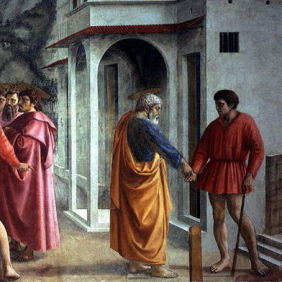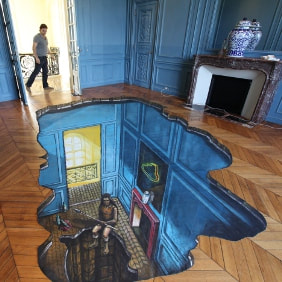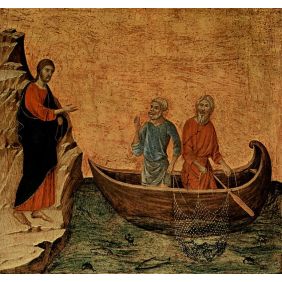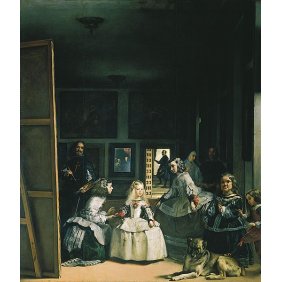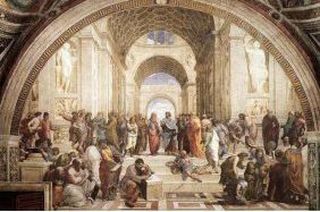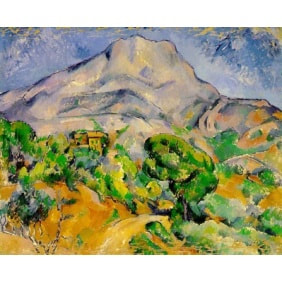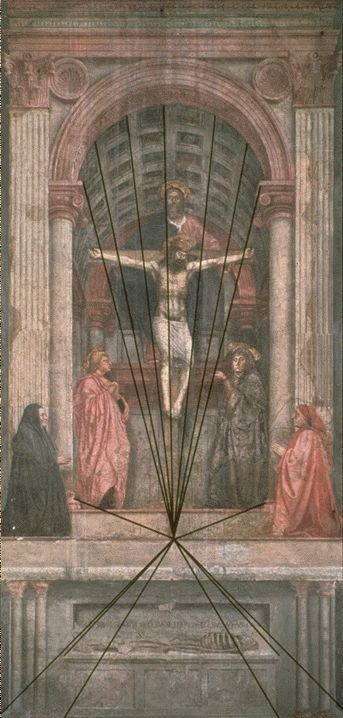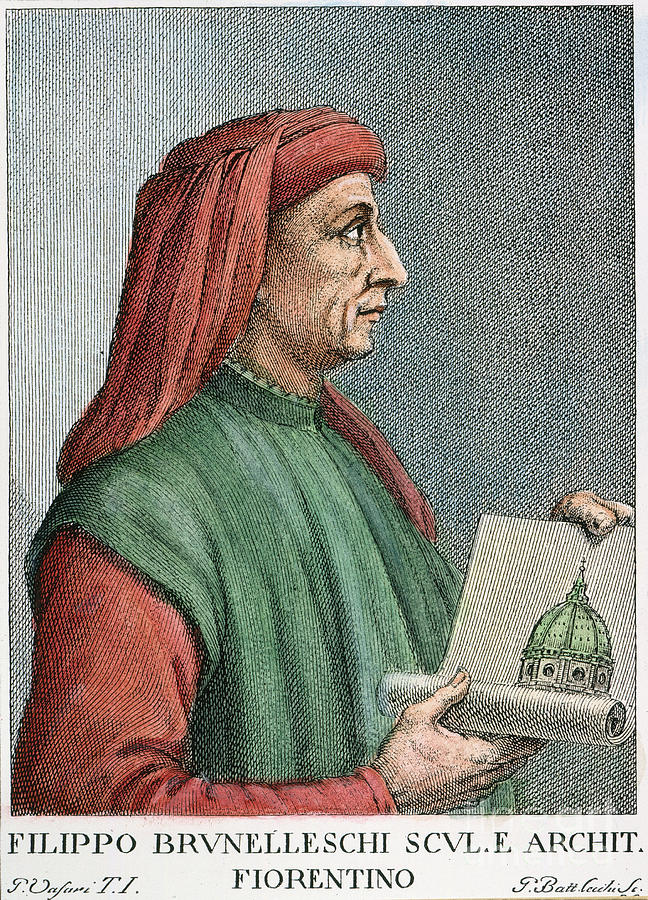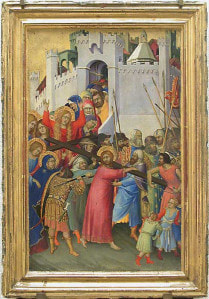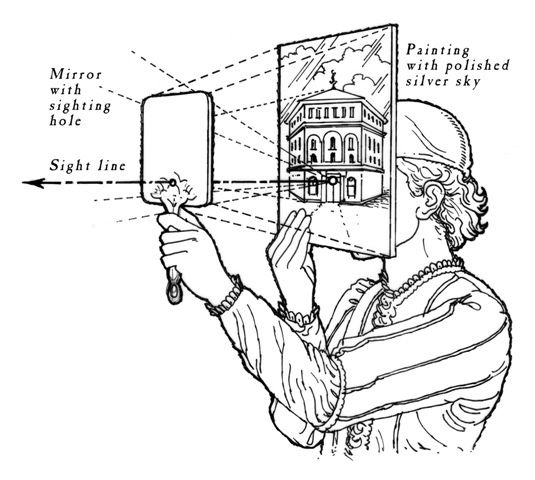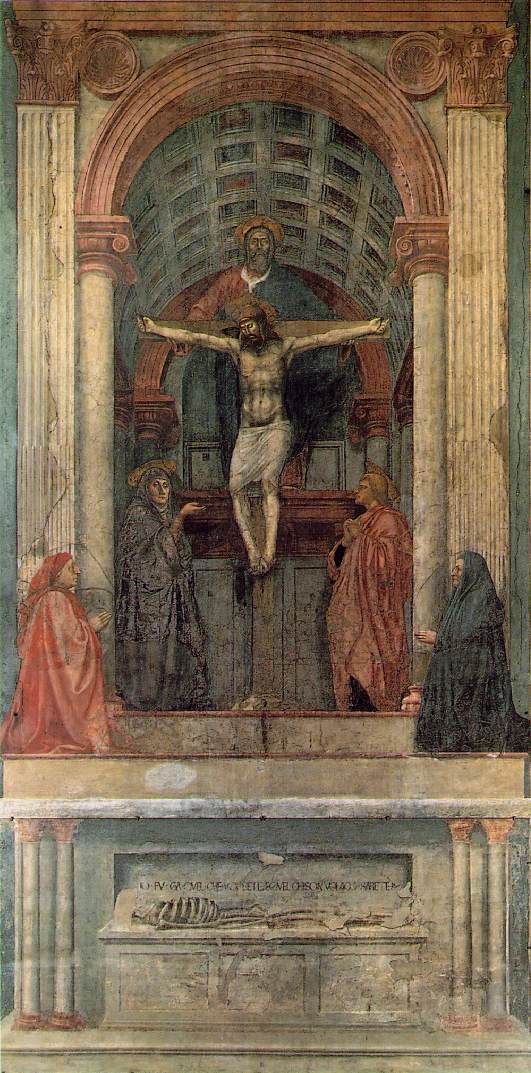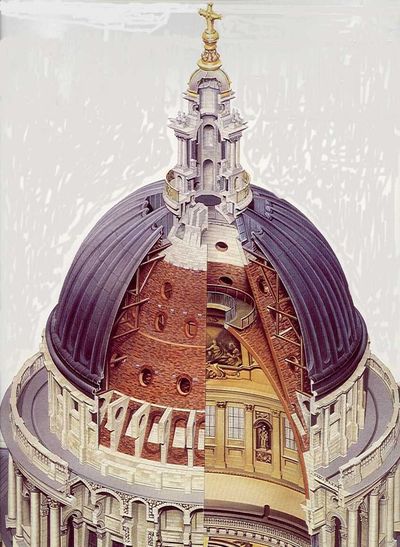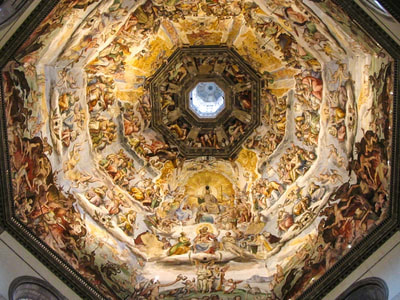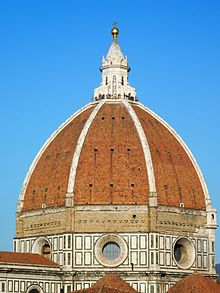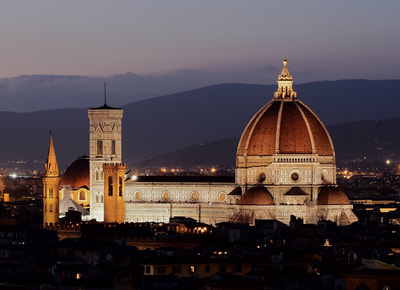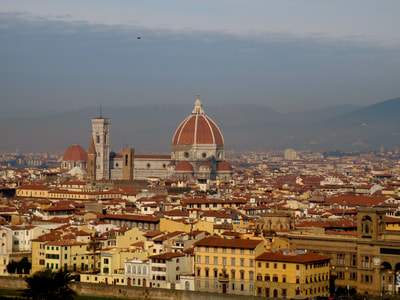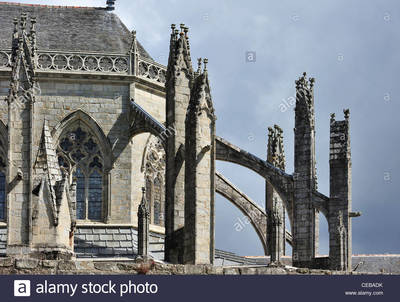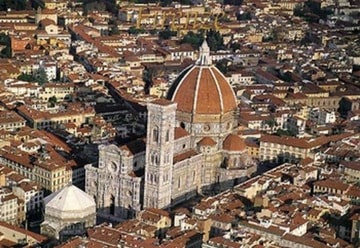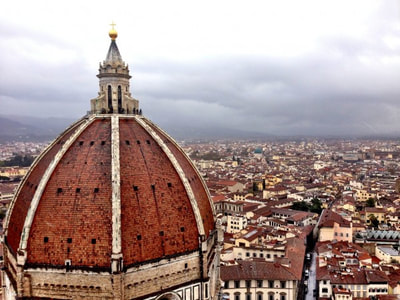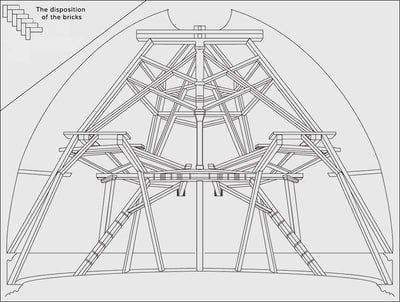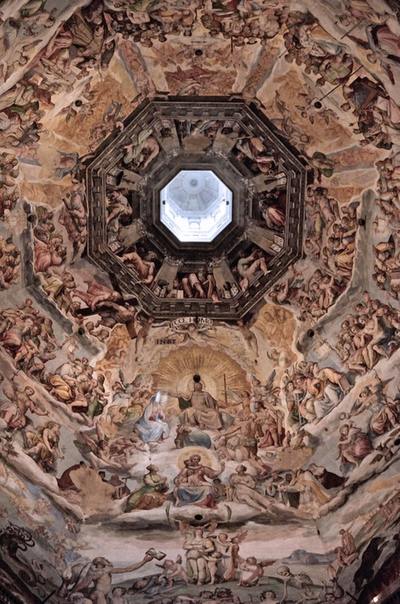History of Perspective
|
Illusion in Art
An artist starts with a two-dimensional surface; it may be a wall, a canvas, a board, paper or a pavement. By the use of paint or other media he must make the viewer enter his world and share his vision. But the actual world isn’t two-dimensional and the artist can’t create a three dimensional world on the surface. How do we get around this problem? The answer is illusion – to represent the three dimensional world on the two dimensional surface the artist has to use systems of illusion that create the impression of space, of depth and of movement. The pavement artists 3D Joe and Max (shown right) are masters of this kind of perspective trickery, creating pavement (and floor) art that when looked at from a certain viewpoint gives a startling and visually confusing three dimensional illusion. Art Before Perspective
The Calling of the Apostles c.1308-1311 Duccio di Buoninsegna The system of perspective we take for granted today is a relatively recent discovery in artistic history. Before the 14th Century little to no attempts were made to realistically depict the three dimensional world in art in the way in which we are now accustomed to seeing it. The art of the Byzantine, Medieval and Gothic periods was rich and beautiful, but the images made no attempt to create the illusion of depth and space. The Italian masters Giotto (c. 1267 – 1337) and Duccio(c. 1255-1260 – c. 1318-1319) began to explore the idea of depth and volume in their art and can be credited with introducing an early form of perspective, using shadowing to great effect to create an illusion of depth, but it was still far from the kind of perspective we are used to seeing in art today. |
First Perspective – Fillipo Brunelleschi & Masaccio
Masaccio – The Tribute Money c.1426-27 Fresco, The Brancacci Chapel, Florence The first known picture to make use of linear perspective was created by the Florentine architect Fillipo Brunelleshi (1377-1446). Painted in 1415, it depicted the Baptistery in Florence from the front gate of the unfinished cathedral. The linear perspective system projected the illusion of depth onto a two dimensional plane by use of ‘vanishing points’ to which all lines converged, at eye level, on the horizon. Soon after Brunelleshi’s painting, the concept caught on and many Italian artists started to use linear perspective in their paintings. Masaccio (1401 – 1428) the first great painter of the early Renaissance period, was the first artist who demonstrated full command of the new rules of perspective; the figures in his paintings have volume and the buildings and landscapes realistically recede into the distance. Masaccio is seen now as being the initiator of the new style of Florentine Realism. |
|
The Renaissance in Perspective
Raphael – The School of Athens c.1510-11 Fresco, Vatican, Stanza della Signurata By the late 15th Century, artists were in total command of perpective and were able to create in their art a beautiful and realistic world. The great painters of the time were using the system first created by Brunelleschi to wonderful effect. Underlying these changes in artistic method and the use of perspective was a renewed desire to depict the beauty of nature, and to unravel the axioms of aesthetics, with the works of Leonardo, Michelangelo, Raphael, Botticelli, Donatello and Titian representing artistic pinnacles that were to be much imitated by other artists. The developments were not limited to Italy; in the Netherlands, a particularly vibrant artistic culture developed, with the work of Hugo van der Goes and Jan van Eyck having particular influence on the development of painting in Italy, particularly stylistically in terms of naturalism in representation. Paul Cézanne – A Different Perspective
Cezanne – Mont Ste-Victoire from the South West – 1890-1900 Oil on canvas Towards the end of the 19th Century French painter Paul Cézanne (1839 – 1906) began to question the underlying structure of his subjects. At points his works became almost abstracted, the canvas being covered with thick layers of pigment often applied with a palette knife, the naturally occuring forms simplified to their geometric essentials. Importantly, Cézanne had begun to ignore the laws of classical perspective, allowing each object to be independent within the space of a picture while letting the relationship of one object to another to take precedence over traditional single-point perspective. This was perhaps the beginning of the end of academic composition following the long established rules of perspective. Heavily influenced by Cezanne, several young artists were soon to radically break the mould and themselves become major influences on 20th Century art. |
Perspective Established
Diego Velázquez – Las Meninas – 1656–57 Oil on canvas, 318 x 276 cm For the next five centuries, Brunelleschi’s system of perspective was used to create the illusion of depth on the picture plane and was used as the basis of the great art of Western culture. The Baroque painters (approx. 1600-1750), notably Caravaggio, Annibale Carracci, Gianlorenzo Bernini, Rubens, Rembrandt, Velazquez and Vermeer used this now long established system in thousands of varied approaches, as did the Neoclassicist painters (1750-1850). The use of perspective in art to depict reality continued through the works of the Impressionists (such as Renoir, Monet and Pissarro) and was even used in the works of the Post Impressionists (such as Vincent Van Gogh, Gauguin and Seurat). It was around the time of the Post Impressionists however that a significant change in direction took place. |
Brunelleschi
(the inventor of perspective)
|
Filippo Brunelleschi is probably not among the names most people associate with the Renaissance, but he should be. He was a true genius and one of the greatest minds around Florence in a time when there were many geniuses. Without his contributions, the Renaissance would have been very different. Brunelleschi (pronounced Bru-nel-less-ski) lived from 1387-1446. He was trained as a goldsmith and entered the famous competition with Lorenzo Ghiberti to create the doors on the Florence baptistry (read that story here). Ghiberti won the commission, possibly because Brunelleschi refused to share the commission. Either way, Brunelleschi went on to change the course of the artistic renaissance in Florence in not one but two enormous ways. Later, he would successfully design and oversee the completion of the enormous red dome on the Florence Cathedral, a structural achievement that was way ahead of it’s time and changed the course of architecture. It could be argued that his greatest achievement was his discovery, or re-discovery, of linear perspective.
Among the cultures of the ancient world, only the Greeks and the Romans had spacial depth in art figured out. That is to say, they understood how to create an image with convincing depth and a painted or sculpted illusion of 3 dimensional space. We know this because we can see it today in works like the Column of Trajan, or the painted villas of Pompeii. During the middle ages, these artistic sensibilities were lost. More accurately, the entire world point of view changed in the middle ages to reflect the church. No longer were artists interested in pursuing perfect depictions of the human body or of the world around them. After 1000 years, artists in Florence were aware that they didn’t know how to create convincing depth in a painting, and they were working hard to develop a system of perspective. You can clearly see this in the work of late medieval and early Renaissance painters. Their pictures have a flat look to them. Just look at this image of Christ being led to his crucifixion. The city in the background appears very small because the figures far off in the distance are the same size as those in the foreground. Also, the parallel lines of the walls do not recede into the distance. It’s an image and a perfect example of the problem facing painters around 1400. How do you make a picture realistic? It seems so simple to us now, but it was a huge problem that took centuries to solve until Filippo Brunelleschi figured it out. Brunelleschi observed that with a fixed single point of view, parallel lines appear to converge at a single point in the distance. Brunelleschi applied a single vanishing point to a canvas, and discovered a method for calculating depth. In a famous noted experiment, Brunelleschi used mirrors to sketch the Florence baptistry in perfect perspective. He was able to mathematically calculate the scale of objects within a painting in order to make them appear realistic. It was a monumental discovery, and soon artists were using Brunelleschi’s method of perspective to astonishing affects in their paintings. Brunelleschi’s original perspective studies are long gone, but he directly influenced many others. The first known painting to show true linear perspective is Masaccio’s “The Holy Trinity”. In the fresco, a false room has been created on the flat wall of the church using perspective to simulate the architecture. One of the most important painters of the Renaissance is Masaccio. He died at 26 years old and only 4 works of his survive, but in that time made huge advances in art that greatly impacted later artists. He is the first painter to use true linear perspective in a painting. For a century, artists had been trying to create a system for perspective without success. Masaccio established the use of a horizon line and vanishing point to create the illusion of 3-dimensional depth on a wall in the church of Santa Maria Novella in Florence. The work, made in 1427 and called “The Holy Trinity”, depicts God the Father and Christ directly above a skeleton, symbolic of Adam and the death of man being conquered by the Trinity. Setting the subject aside, the figures reside in a false room painted to match the vaults in the rest of the church. The bottom of the work is 6 feet off the ground- so standing below, the illusion of a real room is created. It was seen as a huge triumph. |

